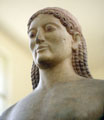
Anavyssos Kouros head and shoulders from front right

Anavyssos Kouros from back left

Anavyssos Kouros pedestal

Anavyssos Kouros upper body from front left

Anavyssos Kouros from front

Anavyssos Kouros from front left
| Collection: | Athens, National Archaeological Museum |
| Title: | Kroisos |
| Context: | Probably from Anavyssos (Vari) |
| Findspot: | Found at Anavyssos (in 1936) |
| Summary: | Funerary statue |
| Object Function: | Funerary |
| Material: | Marble |
| Sculpture Type: | Free-standing statue: kouros |
| Category: | Separated fragments |
| Style: | High Archaic |
| Technique: | In-the-round |
| Original or Copy: | Original |
| Date: | ca. 530 BC - ca. 520 BC |
| Dimensions: | H. 1.94 m |
| Scale: | Life-size |
| Region: | Attica |
| Period: | High Archaic |
| In Whole: | Kroisos |
Subject Description: The kouros, Kroisos, stands in a frontal posture, with his left foot slightly advanced. He holds his arms, which are separated from his body, at his sides, and clenches his fists. He is unusually fleshy, which suggests to Stewart (122) East Greek influence. His hair is arranged in ringlets below a narrow taenia, but is summarily worked on the crown (as if he is wearing a skull cap). The locks of his hair, arranged strands of circular clumps, fall in a curve behind down his back, and are rounded on the sides.
Date Description: This kouros is in Richter's "Anavysos-Ptoon 12 Group."
Condition: Nearly complete
Condition Description:
Reconstructed, and restored, with plaster filling in missing parts on the left arm, left hand, left leg, and right heel; feet broken off beyond the heel. The surface is somewhat chipped and scratched, especially on the face (nose and right eye). Richter (118) notes that the statue was sawn for export in modern times, at the waist, knees, ankles, wrists, and above the left elbow, although the fracture of the right foot is ancient.
There are traces of red color on the hair, taenia, iris, and public hair.
Material Description:
'Parian' according to Richter (119)
Collection History:
The statue was seized by Greek police in Paris, and then returned to Greece in 1937.
Sources Used: